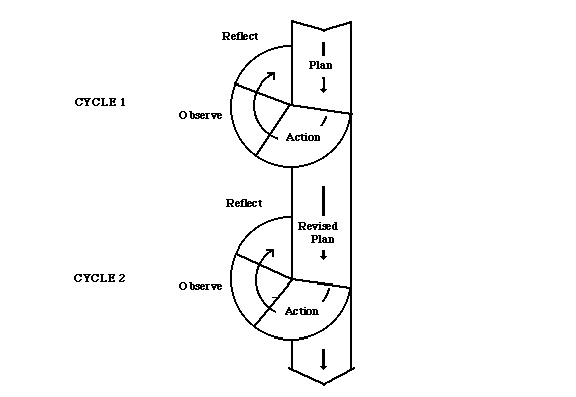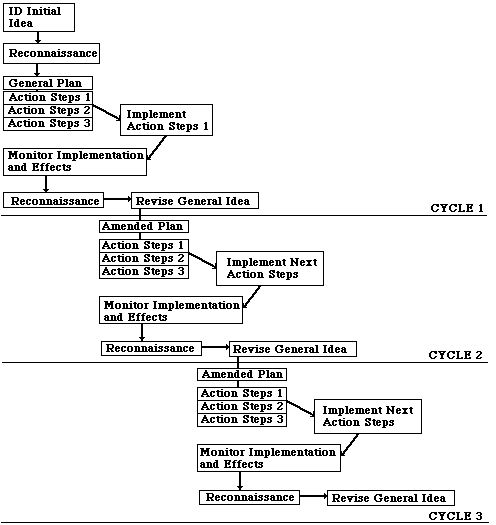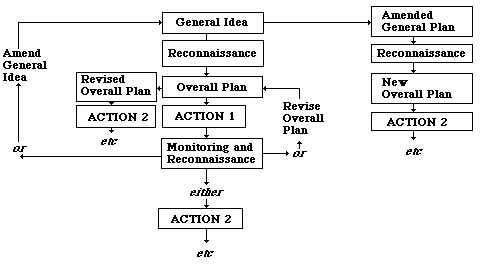
I feel that we need to make a greater effort to involve teachers in Action Research. Teachers already know much about teaching--more than many of us do. But many are waiting to be invited to participate in research studies in which they examine students' preconceptions, or effective teaching strategies. It is through joint research studies that science instruction in the schools will improve, and we need to make a great effort in this regard.Dorothy Gabel
Action Research (AR) represents a growing field of educational research whose chief identifying characteristic is the recognition of the pragmatic requirements of educational practitioners for organized reflective inquiry into classroom instruction. AR is an process designed to empower all participants in the educational process (students, instructors and other parties) with the means to improve the practices conducted within the educational experience (Hopkins, 1993). All participants were knowing, active members of the research process.
Action research has been described as an informal, qualitative, formative, subjective, interpretive, reflective and experiential model of inquiry in which all individuals involved in the study are knowing and contributing participants (Hopkins, 1993). Action research has the primary intent of providing a framework for qualitative investigations by teachers and researchers in complex working classroom situations.
Some of the most widely accepted definitions of Action Research include following:
[Action Research] ...aims to contribute both to the practical concerns of people in an immediate problematic situation and to the goals of social science by joint collaboration within a mutually acceptable ethical framework.
- Rapoport (cited in Hopkins, 1985)
Action Research is a form of self-reflective enquiry undertaken by participants in social (including educational) situations in order to improve the rationality and justice of (a) their own social or educational practices, (b) their understanding of these practices, and (c) the situations in which the practices are carried out. It is most rationally empowering when undertaken by participants collaboratively...sometimes in cooperation with outsiders.
- Kemmis (cited in Hopkins, 1985)
[Action Research] ...is the systematic study of attempts to improve educational practise by groups of participants by means of their own practical actions and by means of their own reflection upon the effects of those actions.
- Ebbutt (cited in Hopkins, 1985)
The action research framework is most appropriate for participants who recognize the existence of shortcomings in their educational activities and who would like to adopt some initial stance in regard to the problem, formulate a plan, carry out an intervention, evaluate the outcomes and develop further strategies in an iterative fashion (Hopkins, 1993). In short, action research is characterized by those constraints and strengths given a research methodology intended to be a workable technique for working classroom teachers.
The essentials of action research design are considered by Elliott (in Hopkins, 1993) as per the following characteristic cycle:
The protocol is iterative or cyclical in nature and is intended to foster deeper understanding of a given situation, starting with conceptualizing and particularizing the problem and moving through several interventions and evaluations. A representation of an AR protocol by Kemmis is provided in Figure 1.

Figure 1: Action Research Protocol after Kemmis (cited in Hopkins, 1985)
Figure 1 clearly displays the iterative nature of AR along with the major steps of planning, action, observation and reflection before revising the plan . This may be thought of as similar in nature to the numerical computing technique known as successive approximation - the idea is to close in upon a final goal or outcome by repeated iterations.
Later protocols reflect changes in the goal as determined via experience during the reflections of earlier iterations of AR. For instance, Figure 2 reflects the evolution of the general idea or main topic of interest throughout the process.

Figure 2: Action Research after Elliott (cited in Hopkins, 1985)
Elliott's model emphasizes constant evolution and redefinition of the original goal through a series of reconnaissances recurring every cycle. The reconnaissance necessarily includes some degree of analysis. This design permits much greater flexibility, and seeks to "...recapture some of the 'messiness' which the Kemmis version tends to gloss [over] " (Hopkins, 1985). Ebbutt further illustrates the evolution of the overall plan through a spiral analogy, as described in Figure 3.

Figure 3: Action Research Protocol after Ebbutt (cited in Hopkins, 1985)
Another distinguishing characteristic of action research is the degree of empowerment given to all participants. Involvement is of a knowing nature, with no hidden controls or preemption of direction by the researcher. All participants including the university researchers, the teachers and the students negotiate meaning from the data and contribute to the selection of interventionary strategies.
Elliott (in Kemmis & McTaggart, 1990b) considers the need for communication between all participants to be of paramount importance:
Since action research looks at a problem from the point of view of those involved it can only be validated in unconstrained dialogue with them. ...Since action research involves unconstrained dialogue between "researcher" (whether he be an outsider or teacher/researcher) and the participants, there must be free information flow between them. (p. 122)
Perhaps the key component involved in action research is the notion of praxis. Action research is intended to be the reflective counterpart of practical diagnosis (Elliott, 1978). Schon (1983) describes the use of reflection to generate models from a body of previous knowledge. These models are used to re-frame a problem; then experiments are performed to bring about outcomes which are subjected to further analysis. This model (called reflection-in-action) frames means and ends interdependently and recognizes that there is little or no separation of research from practice, little or no separation of knowing and doing. Schon's model of reflection-in-action compliments the iterative and investigative natures of action research.
Hopkins, D. (1985). A teacher's guide to classroom research. Philadelphia: Open University Press.
Kemmis, S., & McTaggart, R. (Eds.). (1990b). The action research reader. Victoria: Deakin University.
Schon, D. A. (1983). The reflective practitioner : How professionals think in action. New York: Basic Books.
A Latvian translation of this webpage by Arija Liepkalnietis can be found at http://www.autoteileprofi.de/science/2017/02/04/ievads-petniecibas-darbibas/
A Polish translation of this webpage by Marie Stefanova can be found at <https://www.bildeleekspert.dk/blog/2017/05/10/wprowadzenie-badania-czynnosci/>